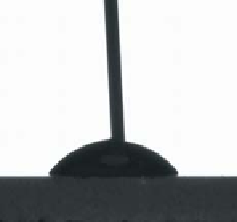Biomedical Engineering Reference
In-Depth Information
(a)
(b)
(c)
Figure 7.12
Contact angle of water on ligninmodel films. (a) softwood kraft lignin film;
(b) softwood (RadiataPine)milledwood ligninfilmand (c) hardwood (EucalyptusRegnans)
milledwoodligninfilm.
where sourcing water has been an issue throughout evolution. Kohonen has shown that
water transport though the lumen of wood tracheids is aided by a combination of surface
chemistry, which is predominantly lignin, and surface structuring, the so-called warty
layer (Kohonen 2006). The surface structuring leads to a reduction in the contact angle
of water, which may be described theoretically according to Wenzel's equation (Hunter
1993), increasing the wettability and hence transport of water due to the effect of the
Laplace pressure.
The preparation of model surfaces also provides an excellent opportunity to study the
properties of single lignin macromolecules. This may be probed by stretching lignin
polymers away from the surface by some specific physisorption interaction with an
atomic force microscopy tip in a method which has been termed single molecule force
spectroscopy (Rief
et al
. 1997, Chattelier
et al
. 1998). Only a few polymer chains are
pulled away from the surface, with each chain causing an 'event' which can be observed
in the force-distance curve as shown in Figure 7.13 (Notley and Norgren, manuscript
in preparation). Typically, the shape of the events in the force-distance curve gives an
indication of the solvency of the polymer in the solvent into which it is being stretched
(Chattelier
et al
. 1998, Senden
et al
. 1998). A good solvent gives rise to 'Langevin'
type interaction curves that may be described as an increasing, nonlinear adhesion force
with separation before desorption back to the baseline. The increasing adhesion is due
to the decrease in entropy as the polymer chain is stretched such that all bonds are
in the
trans
configuration. These curves may be fit using either a freely-jointed-chain
or wormlike-chain model to yield the contour length of the polymer as well as the
persistence length. A poor solvent interaction, as shown in Figure 7.13 for a DHP
lignin surface interacting at pH 6 and 1 mM NaCl background electrolyte concentration,
is characterised by a constant force plateau as a function of separation of the probe
from the surface. If more than one chain is pulled away from the surface, then a
plateau is observed for each chain, with the magnitude of the plateau corresponding to
an integer multiple of the lowest force. In Figure 7.13, 6 plateaus can be observed,
each a multiple of about 78 pN. If the surface energy of the solid polymer is known
(in this case 58 mJ m
−
2
), then the molecular radius may be determined. For this DHP
lignin sample, the molecular radius was calculated to be 2.1
A which is of the order



Search WWH ::

Custom Search